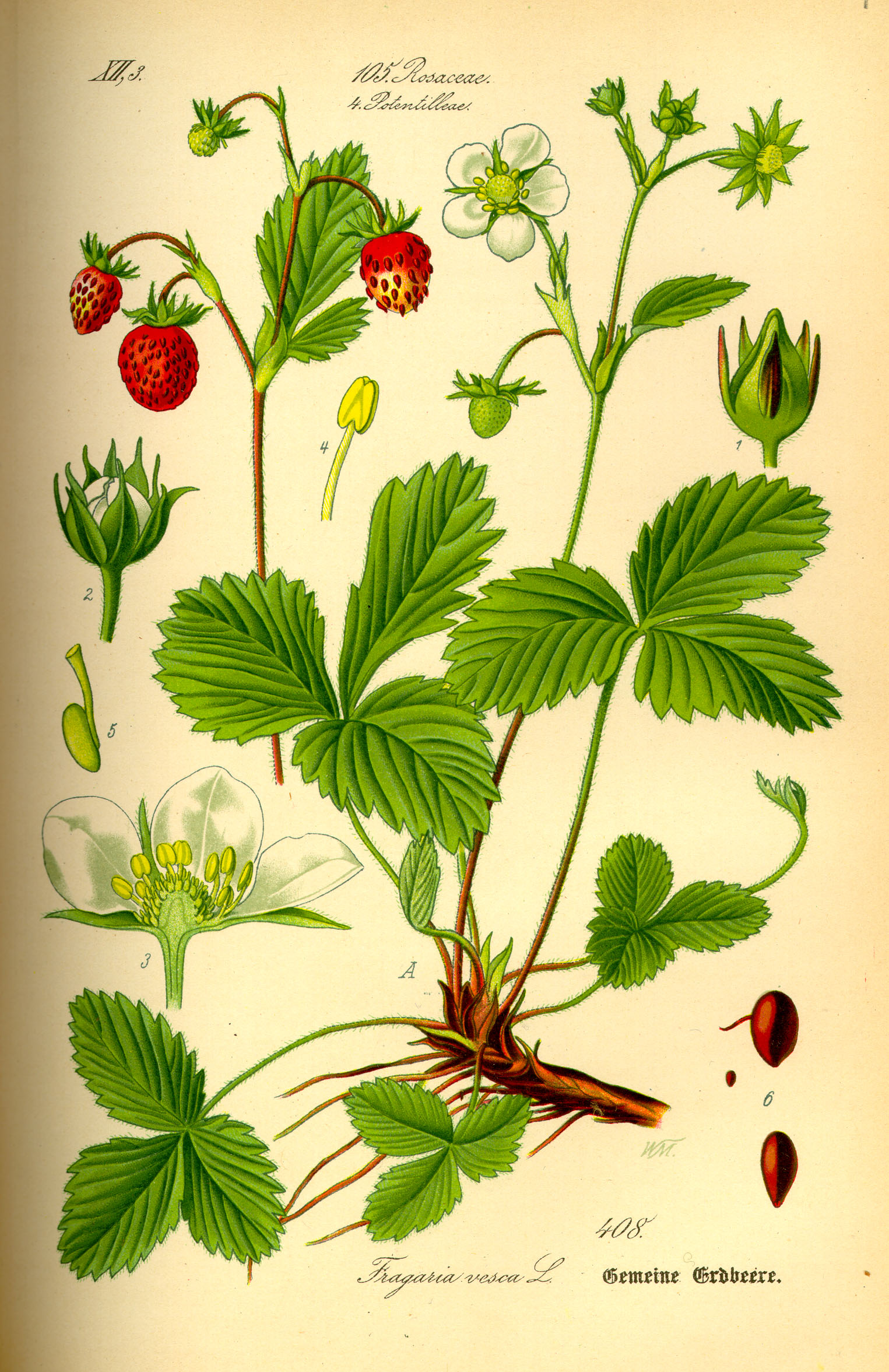- Fragaria vesca
Taxobox
name = Woodland Strawberry

image_width = 240px
regnum =Plant ae
divisio = Magnoliophyta
classis =Magnoliopsida
ordo =Rosales
familia =Rosaceae
subfamilia =Rosoideae
genus = "Fragaria"
species = "F. vesca"
binomial = "Fragaria vesca"
binomial_authority = Coville"Fragaria vesca", commonly known as Woodland Strawberry occurs naturally throughout the
Northern Hemisphere . Other names for this species include Fraises des Bois, Wild (European) Strawberry, European Strawberry and Alpine Strawberry the latter usually in reference to the cultivated varieties such as Fragaria vesca 'Semperflorens'.Like all strawberries, it is in the family Rosaceae; its fruit is more technically known as an accessory fruit, in that the fleshy part is derived not from the plant's ovaries (achenes) but from the peg at the bottom of the bowl-shaped hypanthium that holds the ovaries.
Polyploidy
All
strawberry species have a basehaploid count of sevenchromosome s; "Fragaria vesca" isdiploid , having two pairs of these chromosomes for a total of 14.Ecology
Typical habitat is along trails and roadsides, embankments, hillsides, stone and gravel laid paths and roads, meadows, young woodlands, sparse forest , woodland edges and clearings. Often plants can be found where they do not get sufficient light to form fruit. The fruit are eaten and the achenes in this way spread by numerous mammals and birds.
In the southern part of its range, it can only grow in shady areas; further north it tolerates more sun. It is tolerant of a variety of moisture levels (except very wet or dry conditions). It can survive mild fires and/or establish itself after fires.
Although "F. vesca" primarily propagates via runners, viable seeds are also found in
soil seed bank s and seem to germinate when the soil is disturbed (away from existing populations of "F. vesca").cite web | url = http://www.fs.fed.us/database/feis/plants/forb/fraves/all.html | title = Fragaria vesca | author = Munger, Gregory T. | date = 2006 | work = Fire Effects Information System | publisher = U.S. Department of Agriculture, Forest Service, Rocky Mountain Research Station, Fire Sciences Laboratory | accessdate = 2008-08-06 ]"F. vesca" leaves serve as significant food source for a variety of
ungulate s, such asmule deer andelk , and the fruit are eaten by a variety of mammals and birds.Cultivation and uses
Evidence from archaeological excavations suggests that "fragaria vesca" has been consumed by humans since the
Stone Age . [ [http://intarch.ac.uk/journal/issue1/tomlinson/part2.html#S711 Internet Archaeol 1. Tomlinson & Hall. 7 ] ] The Woodland Strawberry was widely cultivated inEurope until the 18th century, when it began to be replaced by theGarden Strawberry ("Fragaria x ananassa"), which have much larger fruit and showed greater variation, making them better suited for further breeding. Woodland Strawberry fruit is strongly flavored, and is still collected and grown for domestic use and on a small scale commercially for the use ofgourmet s and as an ingredient for commercial jam, sauces, liqueurs, cosmetics and alternative medicine. In Turkey several 100 tons of wild fruit are harvested annually, mainly for export. [Chronica Horticulturae Vol.47 Number 2]Most of the cultivated varieties are by botanists usually set to the subspecies Fragaria vesca 'Semperflorens' and they are usually called Alpine Strawberries. They have in common that they rarely form runners (instead forming multiple crowns in a cluster), fruit over a very long timeperiod and are usually propagated by seeds or division of the plants. Some cultivars have fruit that are white, or yellow when fully ripe, in addition to the normal red. Plants tend to lose vigour after a few years. Cultivars that form stolons are often used as
groundcover , while cultivars that do not may be used as border plants. Some cultivars are bred for their ornamental value. There also exist hybrid cultivars from crosses between Woodland Strawberry and Garden strawberry.The alpine strawberry is used as an indicator plant for diseases that affect the garden strawberry. It also finds use as a genetic model plant for garden strawberry and the Rosaceae family in general, due to its:
*very small genome size
*short reproductive cycle (14–15 weeks in climate-controlled greenhouses)
*ease of propagation"F. vesca" is sometimes used as an herbal medicine; an
herbal tea made from the leaves, stems, and flowers is believed to aid in the treatment ofdiarrhea .Blooms
Fruits
Cultivars
Illustrations
References
[http://www.cvni.org/wildflowernursery/wildflowers/wild-strawberry Conservation Volueers Northern Ireland, About wildflowers: Wild Strawberry] External links
* [http://www.ars-grin.gov/cgi-bin/npgs/html/taxon.pl?264 "F. vesca" information from GRIN Taxonomy Database]
* [http://linnaeus.nrm.se/flora/di/rosa/fraga/fragves.html Den Virtuella Floran] , a Swedish site with good "F. vesca" photos
* [http://www.pfaf.org/database/plants.php?Fragaria+vesca+%27Semperflorens%27 Plants for a future Fragaria vesca 'Semperflorens']
* [http://www.pfaf.org/database/plants.php?Fragaria+vesca Plants for a future Fragaria vesca]
* [http://plants.usda.gov/java/profile?symbol=FRVE&photoID=frve_004_ahp.tif PLANTS Profile USDA] Distribution maps for the USA
* [http://www.funet.fi/pub/sci/bio/life/plants/magnoliophyta/magnoliophytina/magnoliopsida/rosaceae/fragaria/index.html#vesca http://www.funet.fi/pub/sci/bio/life/plants/magnoliophyta/magnoliophytina/magnoliopsida/rosaceae/fragaria/index.html#vesca] Lists what insects it is foodplant for.
* [http://www.topwalks.net/plants/red/fragaria_vesca_more.htm Fragaria vesca photos on 'Topwalks']
Wikimedia Foundation. 2010.
